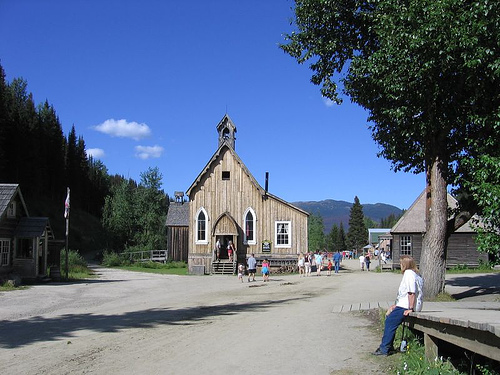

Location: British Columbia Map
Found: 1862
Barkerville Ghost Town is situated in a province of British Columbia
in Canada. Barkerville was originally found in 1862 and named after
prospector William Barker who struck it rich a year earlier founding
a large deposit of gold. Although some historians claim that the
name of the ghost town is owed to barking of the local packs of
wolves. Barkerville grew quickly inviting people from other regions
of the country as well as China. Chinese became an important part of
the city opening many businesses here. During hey day Barkerville
was the largest city in the Western Canada, but it lucks soon turned
sour. Gold mining became less productive, resources of the
settlement dwindled. The city was largely abandoned by the end of
the century due to declining source of precious metals. It had a
brief increase in population during the Great Depression, but it was
short lived. Unlike most other cities in the West Barkerville was
not completely forgotten. In 1958 Canadian government undertook a
restoration project to attract tourists.
In 1957, the
government of British Columbia decided that the town should be
restored and operated as a tourist attraction. Today, Barkerville
appears as it did in its heyday and is referred to as Barkerville
Historic Town. The history of each building has been researched and
documented. No residents remain; they were either bought out or
moved to New Barkerville during the restoration of the site.
In 2008, Barkerville's Chee Kung Tong Building was designated a
National Historic Sites of Canada. The two-storey board and batten
structure was completed in 1877 and originally used by the Chee Kung
Tong organization, a benevolent association for recent arrivals. It
is representative of the community building among immigrant Chinese
laborers and merchants in new settlements throughout Canada.
Barkerville emerged as a gold rush town. After Billy Barker
(1817-1894) was one of the first gold prospectors in the Cariboo region,
a number of new places emerged such as Barkerville, Keithley Creek,
Quesnel Forks, Antler, Richfield, Fort Alexandria and Horsefly. The area
known as the Cariboo attracted many gold seekers, many of whom had
followed the Fraser Canyon Gold Rush three years earlier. They now moved
further north, but with more and more gold discoveries, the reputation
of the area also reached Europe, and numerous men made their way there.
Barkerville became the largest town north of San Francisco and west
of Chicago. Barker's gold discovery - his claim was so rich that it
yielded 37,500 ounces of gold - triggered the immigration of thousands
of fortune seekers within just a few weeks.
The area's remoteness
and skyrocketing demand caused prices for food and equipment to
skyrocket. It was only with the construction of the Cariboo Road (also
called the Cariboo Wagon Road or Great North Road), a cart route that
Governor James Douglas initiated in 1861 and which was completed in
1865, that goods came into the town in sufficient quantities so that
prices rose again normalized. The Hudson's Bay Company, which at that
time was still a major power in the west of what would later become
Canada, initially feared that the expected onslaught of Americans could
lead to a later annexation of the entire area, just as the company had
already built its forts in 1849 had lost in Washington and Oregon. This
time there were only a few Americans there because most of them returned
to their homeland, which had been torn apart by civil war.
At
first the place consisted only of tents and simple huts, but the
population grew to over 5,000 residents. Shops were opened to meet basic
needs, restaurants, 20 saloons alone were opened, a theater (the Theater
Royal) and brothels, soon a daily newspaper was published and even a
literary society, the Cariboo Literary Society, and a Masonic lodge were
founded.
The government made gold mining dependent on a license.
There was a police force and a court, with Judge Matthew Baillie Begbie
earning the nickname “the hanging judge.” He did not shy away from death
sentences or forced labor and, to the dismay of some Californians, took
the testimony of Indians and Chinese as seriously as anyone else's.
On September 16, 1868, many of the city's wooden houses were
destroyed by fire, but 90 buildings were rebuilt within six weeks. Now
the narrow Main Street was widened, sidewalks were created, and in 1880
the first school with 13 students was built.
With the end of the
gold rush, most residents left the city. At the same time, Chinese
people immigrated, whose number in the Cariboo area rose from two to
three hundred to 1,100 to 1,200 between 1881 and 1884, according to
local MP Charles Wilson. They acquired claims and prevailed despite the
use of violence against the resistance of the whites. In the business
sector, Chinese companies such as the Kwong Lee Company became
indispensable. The Chinese community was extremely frugal, the men lived
in small spaces, and people helped each other by setting up charitable
societies. The municipality resolved legal disputes internally, without
resorting to provincial jurisdiction. The hard-working and thrifty
Chinese often took over claims that had already been abandoned by
Europeans. However, they were unable to stop the population decline.
A brief revival was caused by the Great Depression with its sharply
rising gold prices, which once again attracted prospectors to
Barkerville.
In 1958, the provincial government decided to
restore the almost abandoned place and to examine the history of each
individual house. The few residents left the place, e.g. T. with
government support, and moved to New Barkerville during the restoration
work. In addition to the historic site, the “Barkerville Historic Town”
was created, where scientists continue to work on the historical
research of the neighboring ghost town.